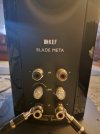bo_knows
Addicted to Fun and Learning
Measurements used from Erin's Audio Corner for KEF reference 1 meta.Given the wide dispersion on these I don't see why this observation should come as a surprise to you or be that unlikely. I'm demoing the LS50 meta's right now and they also are fairly happy pointed parallel to each other, just as my Snell's are. My understanding is that there is both an imaging advantage for some speakers and a simple "usefulness" advantage. The latter is easy to appreciate - wider sweet spot, more happy listeners. The former I'm not so sure about. Some speakers really only image well when pointed almost or directly at the listener. Just experienced this with a pair of Fyne 502SP's, where the imaging just completely collapsed at anything wider than more or less straight at me. Actually my chief concern for them atm because I'm not sure how narrow the sweet spot will be when listening to these in other rooms. The LS50's are tentatively imaging fairly well set up parallel but more testing is warranted and I'm not final on that and I'm feeling like my favorite thing about the LS50's will be their dynamicism and crystal-clear highs rather than their imaging. From years of experience I can say that my Snell E/III's (with their wide box shape and effectively flat baffle design) are at their best parallel to each other and image fairly well for such a non-ideal shape. I haven't watched the video and have no idea how competent this reviewer is but I would hope they reached their recommendation by playing with different amounts of toe-in and found this to be best, which is not a hard thing to do. If you don't trust them that's totally reasonable- what more do we have to go on than the sum of their reviews...
Not really sure about that second suggestion. Speakers with really wide dispersion patterns seem to make for challenges in narrow rooms so maybe this guy is observing wall reflections and not correctly identifying why they are experiencing them. I'm testing the LS50's in a great room for this because the speakers are on the long wall of a room that's 17x24 and they are quite happy in that space.
I will make an assumption that KEF Ref 3 meta has a similar horizontal frequency response.
The response will slope even worse the further you are sitting from the speakers and if the room is highly absorptive.
As you can see the more you are sitting away from the on-axis response (speakers pointing straight ahead towards your ears), the more upper midrange and high frequency drop off. Meaning, that if you have speakers pointed straight ahead, FR will be slopped down and you will hear fewer upper frequencies.
This will make the speaker sound mellow, dull, and more relaxed (pick your word to describe the lack of upper frequencies).
Now, couple this with the aging ears (mind included and nothing personal), and you will not get the best FR, stereo image, or focus in the middle (phantom center speaker).
What you will get (and no argument from me) will be a bigger and less focused "sound stage" and a more relaxed presentation.
This will be a personal choice but if one is striving for a more accurate FR response, stereo image focus and etc, then speakers' tweeters should be crossed slightly behind one's ears ( 1-2 feet behind the MLP).
As for speakers not working in a small room, well I and I'm sure other KEF Ref 3 owners will disagree as well.
Is all about the room dimensions and acoustical treatments. Also, speaker bass reflex ports allow for some bass tuning.
No, I wouldn't recommend this or any larger floor-standing speaker in a small room without any room treatments.
Maybe that's what Steve had in mind.
Below are Erin's subjective listening comments:
- On-axis is surprisingly nice (expected a bit of a rise as other Kef speakers have shown in the EIR). I initially had them turned off-axis expecting the sound to be too treble-heavy on-axis. Instead what I found was that the HF was too subdued. Putting the speakers practically directly on-axis was much better to me and balanced out the tonality as well as the soundstage.
Last edited:


